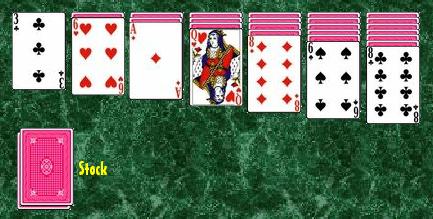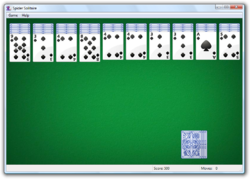.gif)
Spider (solitaire)
Encyclopedia
.jpg)
Patience (game)
Patience is a genre of tabletop games, consisting of card games that can be played by a single player. Patience games can also be played in a multiplayer fashion....
game. It is one of the more popular two-deck solitaire games.
The game
The main purpose of the game is to remove all cards from the table, assembling them in the tableau before removing them. Initially, 54 cards are dealt to the tableau in ten piles, face down except for the top cards. The tableau piles build down by rank, and in-suit sequences can be moved together. The 50 remaining cards can be dealt to the tableau ten at a time when none of the piles are empty.Variants
- Gigantic Spider: Four decks
- Relaxed Spider: doesn't require all spaces to be filled before redealing
- Spiderette: Only one pack, Klondike layout; see below
- Spiderwort: Three decks
- Will o' the Wisp is another solitaire card game which was invented by Geoffrey Mott-Smith and is played the same way as Spiderette. The exception is that on the onset, twenty-one cards are dealt into seven columns of three with only the top card of each column face-up.
Spiderette
Spiderette is the one-deck version of Spider. This game should not be confused with Little SpiderLittle Spider
Little Spider is a solitaire card game using a deck of 52 playing cards. Because of its form of game play and dealing, it should not be confused with two other solitaire games: Spider and its one-deck cousin Spiderette.Game play is composed of two parts...
, which is played differently.
The first 28 cards are dealt the same way as in another popular solitaire game Klondike
Klondike (solitaire)
Klondike is a Patience game . Many people refer to Klondike as patience or solitaire .- Rules :...
, i.e. the first column should have one face-up card, the second column should have one face-up card and one face down card at the bottom, and so on.

Once a suit sequence of thirteen cards from king down to ace is successfully built, it is discarded from the game. The game is won when four such suit sequences were built and discarded this way.
Software implementations

Windows Vista
Windows Vista is an operating system released in several variations developed by Microsoft for use on personal computers, including home and business desktops, laptops, tablet PCs, and media center PCs...
, ME and XP
XP
XP may refer to:*Windows XP, an operating system by Microsoft*Office XP, a Microsoft Office version*ΧΡ are the Greek letters that form the Labarum, or the first two letters of "Christ" in Greek*Athlon XP, a line of central processing units by AMD...
versions of Microsoft Windows
Microsoft Windows
Microsoft Windows is a series of operating systems produced by Microsoft.Microsoft introduced an operating environment named Windows on November 20, 1985 as an add-on to MS-DOS in response to the growing interest in graphical user interfaces . Microsoft Windows came to dominate the world's personal...
, Spider Solitaire
Spider Solitaire (Windows)
Spider Solitaire is a card game that is included in Microsoft Windows. It is a version of Spider. It was first included in Microsoft Plus! for Windows 98.-Features:...
. Spider Solitaire was introduced in the Microsoft Plus! 98 addition pack for Windows 98
Windows 98
Windows 98 is a graphical operating system by Microsoft. It is the second major release in the Windows 9x line of operating systems. It was released to manufacturing on 15 May 1998 and to retail on 25 June 1998. Windows 98 is the successor to Windows 95. Like its predecessor, it is a hybrid...
.
On Unix
Unix
Unix is a multitasking, multi-user computer operating system originally developed in 1969 by a group of AT&T employees at Bell Labs, including Ken Thompson, Dennis Ritchie, Brian Kernighan, Douglas McIlroy, and Joe Ossanna...
operating systems, an early version was developed around 1989 at Sun Microsystems
Sun Microsystems
Sun Microsystems, Inc. was a company that sold :computers, computer components, :computer software, and :information technology services. Sun was founded on February 24, 1982...
. A version of Spider Solitaire typically comes bundled with both the KDE
KDE
KDE is an international free software community producing an integrated set of cross-platform applications designed to run on Linux, FreeBSD, Microsoft Windows, Solaris and Mac OS X systems...
and GNOME
GNOME
GNOME is a desktop environment and graphical user interface that runs on top of a computer operating system. It is composed entirely of free and open source software...
desktop environments on other Unix-like
Unix-like
A Unix-like operating system is one that behaves in a manner similar to a Unix system, while not necessarily conforming to or being certified to any version of the Single UNIX Specification....
operating systems such as Linux and BSD, under the names KPatience and Aisleriot Solitaire, respectively. Versions for Macintosh and most other operating systems are also available.
The Windows version offers three levels of difficulty, with one, two, or four suits. These play modes are equivalent to disregarding suit difference, either within the colors or altogether, and thus can be simulated in the physical card game, though the computer version aids visibility by representing all cards as spades and/or hearts.
Scoring
Different software implementations of spider offer alternative scoring rules. The version from Sun MicrosystemsSun Microsystems
Sun Microsystems, Inc. was a company that sold :computers, computer components, :computer software, and :information technology services. Sun was founded on February 24, 1982...
from 1989 defines the following rules in the manual: 10 points for each initially face down card that gets turned over; 15 additional points for each column where all the face-down cards have been turned over (even if you don't manage to get a space); 2 points for each card that is sitting atop the next higher card of the same suit; 50 points for each completed suit removed from the tableau (in which case you do not also score for the 12 cards sitting atop next higher cards). This yields a maximum score of 990. If you win the game with 4 or more completed suits still in the tableau, add 2 points for each suit after the first three. Thus winning with all eight suits still in the tableau yields a score of 1000.
In the Windows versions of Spider Solitaire, the scoring is calculated with a starting score of 500. One point is subtracted for each move; 100 points are added for each set removed. This gives a theoretical maximum of 1256 points. (No fewer than 44 moves are possible since there are that many cards to turn over.) Any game completed in under 100 moves (>1200 points) should be considered commendable.

